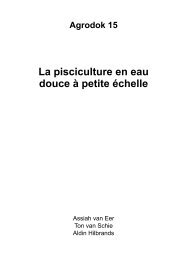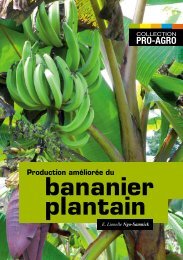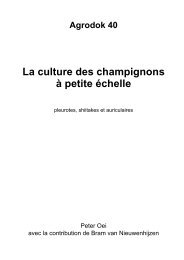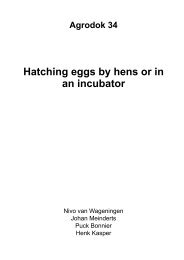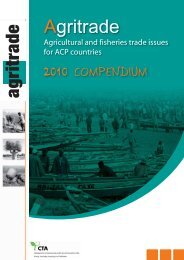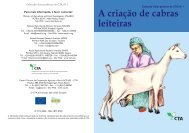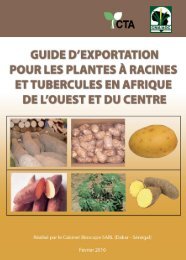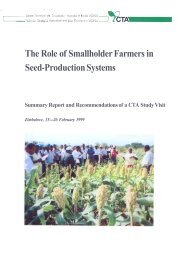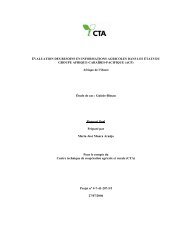La conservation du poisson et de la viande - Anancy
La conservation du poisson et de la viande - Anancy
La conservation du poisson et de la viande - Anancy
- No tags were found...
You also want an ePaper? Increase the reach of your titles
YUMPU automatically turns print PDFs into web optimized ePapers that Google loves.
flexibles <strong>et</strong> pour l’ouverture <strong>de</strong>s grands <strong>poisson</strong>s, un gros couteau soli<strong>de</strong>.Les couteaux doivent être bien aiguisés.Avant <strong>de</strong> commencer le sa<strong>la</strong>ge, le séchage ou le fumage <strong>du</strong> <strong>poisson</strong>, ilfaut agrandir <strong>la</strong> surface <strong>du</strong> <strong>poisson</strong>. Ce<strong>la</strong> favorisera <strong>la</strong> pénétration <strong>du</strong>sel <strong>et</strong> <strong>de</strong> <strong>la</strong> fumée <strong>et</strong> l’évaporation <strong>de</strong> l’humidité. <strong>La</strong> métho<strong>de</strong> <strong>de</strong> n<strong>et</strong>toyageutilisée dépend surtout <strong>de</strong> <strong>la</strong> taille <strong>du</strong> <strong>poisson</strong> :1 Poissons <strong>de</strong> moins <strong>de</strong> 10 cm (anchois, sardines, <strong>et</strong>c.) : on ne r<strong>et</strong>iresouvent que les viscères. Mais ce<strong>la</strong> dépend <strong>de</strong>s habitu<strong>de</strong>s locales <strong>et</strong><strong>de</strong> <strong>la</strong> façon dont on utilisera le <strong>poisson</strong>. Pour certains processus <strong>de</strong>fermentation, on <strong>la</strong>isse les viscères.2 Poissons <strong>de</strong> plus <strong>de</strong> 15 cm : on les n<strong>et</strong>toie <strong>et</strong> on les incise en biaispour agrandir <strong>la</strong> surface <strong>et</strong> amincir <strong>la</strong> chair. Les processus <strong>de</strong> <strong>conservation</strong>sont plus rapi<strong>de</strong>s lorsque <strong>la</strong> surface <strong>de</strong> <strong>la</strong> chair est agrandie.3 Poissons <strong>de</strong> plus <strong>de</strong> 25 cm : on les n<strong>et</strong>toie, on les ouvre en <strong>de</strong>ux <strong>et</strong>on pratique plusieurs incisions supplémentaires dans <strong>la</strong> chair. Parfois,on les découpe en tranches ou en fil<strong>et</strong>s.<strong>La</strong> manière dont le <strong>poisson</strong> est n<strong>et</strong>toyé ne dépend pas seulement <strong>de</strong> sataille, mais aussi <strong>de</strong>s désirs <strong>du</strong> consommateur. Par exemple, certainspréfèrent le <strong>poisson</strong> avec <strong>la</strong> tête, <strong>et</strong> d’autres sans.Nous allons voir maintenant en bref les processus <strong>de</strong> vidage,d’ouverture en <strong>de</strong>ux <strong>et</strong> <strong>de</strong> fil<strong>et</strong>age.Vidage <strong>et</strong> écail<strong>la</strong>ge (figure 1)1 Posez le <strong>poisson</strong> sur une p<strong>la</strong>nche propre <strong>et</strong> tenez-le par <strong>la</strong> tête. Raclezles écailles <strong>de</strong> <strong>la</strong> queue à <strong>la</strong> tête. Evitez d’abîmer <strong>la</strong> peau.2 <strong>La</strong>vez le <strong>poisson</strong> dans <strong>de</strong> l’eau (potable) propre <strong>et</strong> enlevez les écaillesdétachées.18<strong>La</strong> <strong>conservation</strong> <strong>du</strong> <strong>poisson</strong> <strong>et</strong> <strong>de</strong> <strong>la</strong> vian<strong>de</strong>




